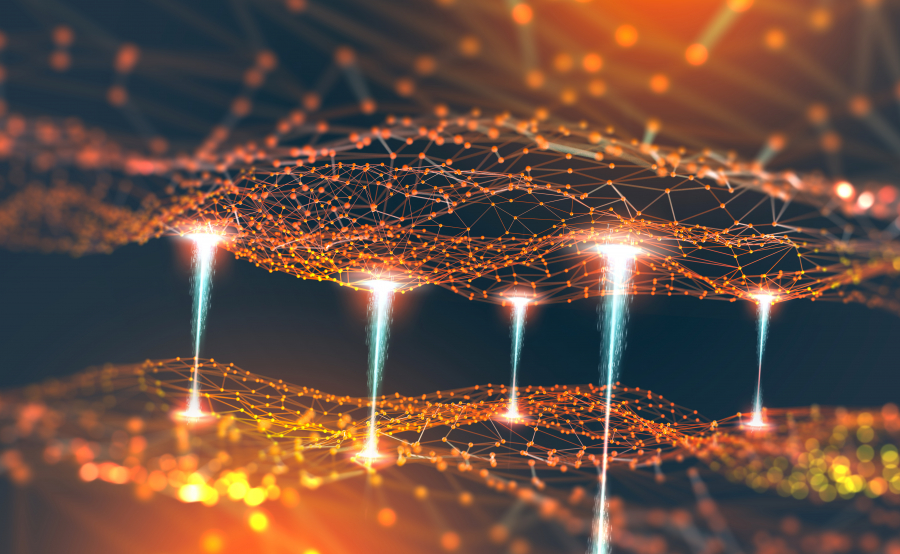Opportunity: The Application of Neuromorphic Processors to SatCom Applications

BACKGROUND
Artificial Intelligence (AI) is set to play a major role in the automation of future satcom systems, enabled by the significant advances in Machine Learning (ML) techniques of recent years. However, the computer processors that AI algorithms will run on have not developed at the same pace, potentially limiting, or delaying the benefits foreseen.
Current-day computers (and most other computational devices) are predominantly based on the classical von Neumann architecture. A basic characteristic of this topology is that computation and memory are implemented as separate elements connected through a common data bus, meaning arithmetic operations and data-fetch cannot occur simultaneously. This so-called “von Neumann Bottleneck” is often the limiting factor for CPUs when applied to tasks where minimal processing of large amounts of data is required. In contrast, neuromorphic processor architectures resemble biological neural networks wherein memory and processing are tightly coupled together, potentially offering faster computational times and drastically reduced energy consumption when applied to tasks requiring massive parallelism. Neuromorphic processors may therefore represent the best approach to unlocking the potential benefits of AI and ML solutions for satcom systems where many of the challenges faced involve matrix-based computational operations, such as in digital beamforming.
An additional benefit of processors based on neuromorphic topologies is that they can be considered fault-tolerant, mimicking neural plasticity in the brain (i.e., they can repair themselves via rerouting around broken synaptic branches, enabling improved reliability via graceful degradation of capability, essentially a bio-inspired radiation hardening alternative).
ABOUT THE PROPOSED ACTIVITY
The proposed activity will take the form of an investigation into the application of neuromorphic processor architectures within satcom systems; focussing on AI-based applications that require massive parallelism/matrix-based computer operations, but also considering other applications where the use of neuromorphic processors could benefit the performance, reliability, power consumption, or cost of satcom payloads.
The activity will assess and compare the performance and implementation of the identified applications when run on standard processor solutions (i.e., GPU/CPUs/ FPGA/ AI-Accelerators, etc.) compared to neuromorphic designs to quantify any gains in terms of computational time, power consumption, reliability, and processor footprint as well as other relevant figures of merit. In addition, the activity should identify new applications that are considered prohibitive to run on standard architecture on-board processors and for which neuromorphic processors therefore represent an enabler. Together with Neuromorphic Processors, the contractor shall research and explore their software technology counterpart. That is, the use of new ML models like Spiking Neural Networks that when implemented on Neuromorphic Processors, exhibit favourable properties such as low power consumption, fast inference, and event-driven information processing. Spiking neural networks or third generation artificial neural networks are a new type of neural networks that functionally mimic natural neural networks even closer than traditional artificial neural networks.
Finally, the study will include a survey of the current state-of-the-art for neuromorphic processor products and solutions, as well as corresponding software toolkits and frameworks, and identify suitable radiation tolerant devices (e.g., novel memristors and MRAM) that could be incorporated into neuromorphic processor-based architectures. A specific goal would be to provide early identification of any industrial dependencies that may exist for critical components.
Finally, the study shall outline the design of a future Proof of Concept demonstrator for a viable satcom application (suitable for realisation through a future ARTES activity), along with a corresponding development roadmap, timescale, and cost envelope.
The overall outcome of the study would therefore be an assessment of whether the application of neuromorphic processors would improve the implementation of existing satcom functions, or enable new capabilities to be realised, and hence represents a technology worth further investigation, along with a potential first step toward realisation.

WHAT WE ARE LOOKING FOR
We are looking for experts in Neuromorphic Processors and technologies, that together with experts in SatCom systems can explore the technological challenges and potential enablers of neuromorphic computing for SatCom applications.
ABOUT THIS OPPORTUNITY
The Invitation to Tender (ITT) is open from 19th of October 2021 for a period of 12 weeks.
Proposals can be submitted via esa-star (please find link below) until 14/01/2022 13:00 GMT+0
https://esastar-publication-ext.sso.esa.int/ESATenderActions/details/19797
ABOUT THE ARTES FUTURE PREPARATION PROGRAM
ARTES FP is a key programme element, in the beginning of the ARTES ‘feeding chain’ that offers the possibility to acquire knowledge on future satcom market perspectives, investigate future system concepts and prepare initial ‘dossiers’ on strategic initiatives; that cannot be developed usually at every Member State’s level. It is based on the concept of a European common effort to produce quality results to set the future of SatCom.
You can find more information in the link below:
https://artes.esa.int/future-preparation
NEUROMORPHICS COMMUNITY AT ESA
For the last two years, we have put together in ESA a team of experts in the fields of Neuromorphic Computing, Event-based sensors, Machine Learning, On-board Payload Data Processing and On-board AI-accelerated hardware to explore the technological challenges and potential enablers of neuromorphic computing in space.
If you would like to engage with this community, please send us an email at tomas.navarro@esa.int or Gianluca.Furano@esa.int


